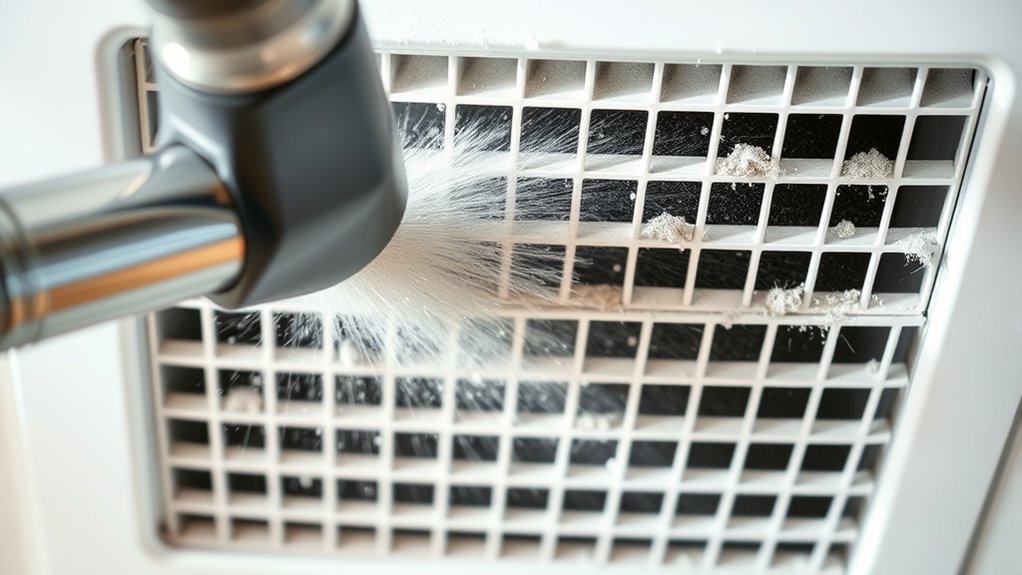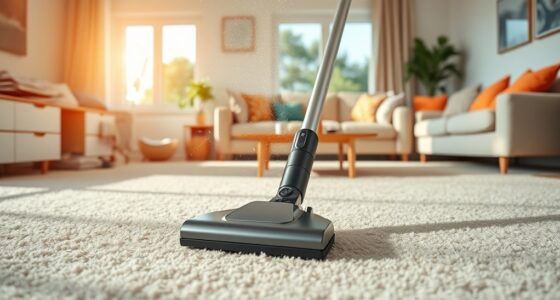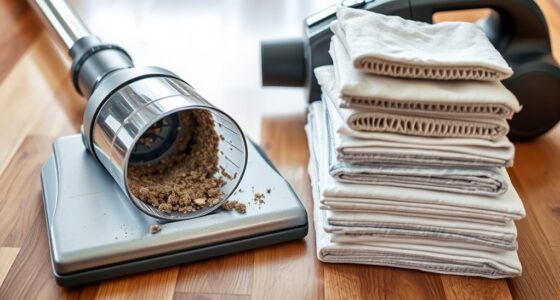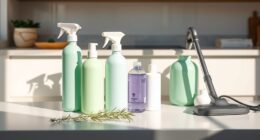Vacuuming your air vents and grilles is a simple way to improve airflow and indoor air quality. Turn off your HVAC system first, then remove the covers carefully. Use a vacuum with a hose attachment to clean both sides of the grilles and reach inside ducts with a long brush or microfiber cloth. Regularly doing this removes dust and debris that block airflow. Keep going to discover more effective tips for cleaner, more efficient heating and cooling.
Key Takeaways
- Turn off the HVAC system before vacuuming vents to prevent dust circulation during cleaning.
- Remove vent covers and thoroughly vacuum both sides to eliminate dust and debris buildup.
- Use a flexible brush or microfiber cloth inside ducts to dislodge and remove accumulated dirt.
- Clear duct openings completely to ensure unobstructed airflow and prevent system strain.
- Regularly vacuum and clean vents to maintain optimal airflow and improve indoor air quality.

Regularly vacuuming air vents and grilles is an easy and effective way to improve your home’s indoor air quality. When you stay on top of this task, you help ensure that dust, dirt, and debris don’t accumulate, which can hinder airflow and compromise air quality. Proper airflow maintenance is essential because it keeps your HVAC system running efficiently and prevents unnecessary strain on the unit. By incorporating simple vent cleaning techniques into your routine, you can significantly enhance the airflow within your home, leading to more consistent temperatures and cleaner air.
To begin, you should start with the right tools. A vacuum cleaner with a hose attachment is ideal for removing debris from vents and grilles. Make sure it has enough suction power to dislodge dust without merely pushing it further into the ductwork. Before you start, turn off your HVAC system to prevent dust from circulating while you’re cleaning. Remove the vent covers or grilles carefully—most can be unscrewed or pulled off with ease. Once removed, use the vacuum hose to clean both sides of the covers thoroughly, paying attention to the slats or louvers where dust tends to settle.
When cleaning the ducts themselves, you’ll want to reach inside as much as possible without damaging the ductwork. Use a long, flexible brush attachment or a microfiber cloth to wipe away dust and debris from the opening. For deeper cleaning, you might consider using compressed air or a vent cleaning brush to loosen stubborn dirt within the duct system. These vent cleaning techniques ensure that dust isn’t just pushed around but is actually removed from the system, promoting better airflow. Regularly changing or cleaning filters also supports airflow maintenance, as clogged filters impede air circulation and cause the system to work harder. Additionally, staying informed about AI vulnerabilities can help you choose safer and more reliable cleaning tools and techniques.
Frequently Asked Questions
How Often Should Air Vents Be Vacuumed for Optimal Airflow?
You should vacuum your air vents and grilles every 1 to 3 months for ideal airflow. Following a regular maintenance schedule helps prevent dust buildup, which can decrease air quality and strain your HVAC system. Use a vacuum with a brush attachment to remove debris effectively. Consistent cleaning not only improves airflow but also contributes to healthier indoor air, making your home more comfortable and safe.
Can Vacuuming Damage Sensitive HVAC Components or Wiring?
You won’t damage sensitive HVAC components or wiring by vacuuming if you’re careful. Avoid excessive force that could cause electrical damage or dislodge connections. Use a gentle, low-suction vacuum and a soft brush attachment to protect component safety. When in doubt, turn off your system and consult a professional. Protecting electrical damage and ensuring component safety keeps your HVAC running smoothly and efficiently.
What Type of Vacuum Attachment Is Best for Cleaning Air Vents?
You should use a brush or upholstery attachment for cleaning air vents, as these vacuum attachment types gently loosen dust without damaging delicate components. These attachments help improve airflow by effectively removing debris from vents and grilles. To get the best results, make certain your vacuum has adjustable suction and move the attachment slowly to dislodge dust. Regular cleaning with the right attachment boosts airflow and maintains better indoor air quality.
Should I Wear Protective Gear While Vacuuming Air Vents and Grilles?
In the age of the Renaissance, safety was often overlooked, but today, you should definitely wear protective gear while vacuuming air vents and grilles. This promotes ventilation safety and shields you from dust, mold spores, and debris. Wearing gloves, a mask, and eye protection minimizes health risks, especially if you’re sensitive or allergic. Prioritizing safety guarantees you clean effectively without risking irritation or respiratory issues.
Are There Any Safety Precautions to Consider During Vent Cleaning?
Yes, you should take safety precautions during vent cleaning. Always disconnect power to avoid electrical hazards, and wear respiratory protection to prevent inhaling dust or mold. Use gloves to protect your skin, and make certain there is good ventilation in the area. Be cautious of sharp edges inside vents, and handle your vacuum carefully to avoid damage or injury. Taking these steps keeps you safe while improving airflow.
Conclusion
By regularly vacuuming your air vents and grilles, you’ll keep your home’s airflow as smooth as a river in full flood. This simple task prevents dust buildup and guarantees your HVAC system doesn’t have to work a million times harder. Think of it as giving your home a gust of fresh air — literally! Don’t wait for poor airflow to become a disaster; take action now and enjoy a healthier, more efficient space that feels like a breath of fresh mountain air every day.









